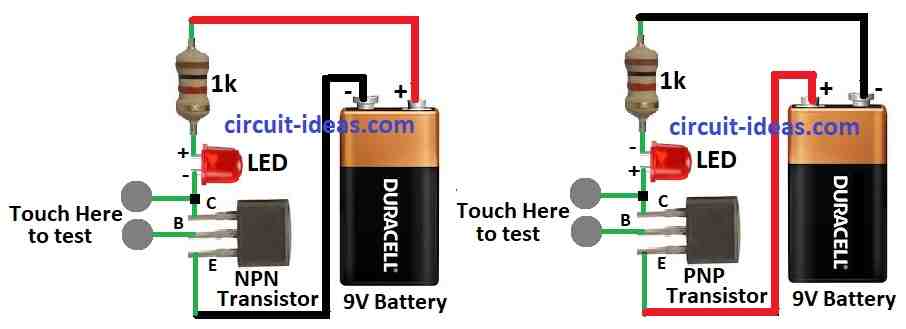Transistors are tiny electronic switches, but how do you know if yours are working or which kind they are?
This tester circuit is like a fortune teller for transistors.
It is a simple DIY project that uses just a few common parts to check if your transistor is alive and tell you if it is an NPN or PNP type like two different flavors.
No decorative tools needed.
Circuit Working:

Parts List for both the diagram:
| Category | Item | Quantity | Additional Specifications |
|---|---|---|---|
| Resistors | 1k | 2 | All resistors are assumed to be 1/4 watt |
| Semiconductors | NPN Transistor | 1 | |
| PNP Transistor | 1 | ||
| LEDs | 5mm LED (any color) | 2 | 20mA rating |
| Battery | 9V | 2 |
Working of a basic transistor tester NPN or PNP:
This quick method uses a 9V battery, 1k resistor and any LED.
Try connecting the transistors leads in different combinations to the circuit shown above until you see the LED light up.
A brighter LED indicates a good connection.
Transistor identification:
The diagrams show how to identify the transistor type NPN or PNP and its leads base, collector, emitter.
You might need to bend the transistors legs to match the positions in the diagrams for better visualization.
This simple tester works for regular, PNP and darlington transistors.
How to Build a NPN Transistor Tester:
For building an NPN transistor:
Connect its collector to the positive of battery through a series connected LED and 1k resistor.
Connect its emitter to negative of battery.
How to test a NPN Transistor.
Switch on the circuit and keep your finger bridging the base and collector of the NPN transistor.
If the LED illuminates in response to your touch, then the transistor can be assumed to be good.
Any other result will indicate a bad transistor
Formulas:
Transistor tester circuit design and analysis need the application of a few fundamental formula and ideas.
The following formulas are relevant to the design of these circuits:
Ohms Law:
V = I * R
where,
- V stands for the voltage across the resistor (or any other component)
- I for the current flowing through it and,
- R for resistance.
Calculating the Current Limiting Resistor:
In order to prevent damage to the LEDs in the circuit, you must make sure they are receiving the appropriate current.
The current limiting resistor R may be found using the following formula:
R = VS−VLED / ILED
where,
- VLED is the forward voltage drop of the LED (usually 1.8V to 3.3V depending on the color and kind of the LED)
- VS is the supply voltage e.g. a 9V battery
- ILED is the required current through the LED e.g. 20mA or 0.02A.
Power Dissipation:
Determine power dissipation using the following formulas to make sure the components are functioning within safe bounds:
P = V * I
where,
- The components voltage drop across it is represented by V its current through it by I, and its power by P.
For resistors:
PR = I2 * R
For transistors:
PCE = VCE * IC
where,
- The collector current is IC, while the power wasted by the collector emitter junction is PCE.
You may properly construct and debug transistor tester circuits with the aid of these formulas and principles.
How to Build PNP Transistor Tester
For building an PNP transistor:
Connect its collector to the negative of battery through a series connected LED and 1k resistor.
Connect its emitter to positive of battery.
How to test a PNP Transistor.
Switch on the circuit and keep your finger bridging the base and collector of the NPN transistor.
If the LED illuminates in response to your touch, then the transistor can be assumed to be good.
Any other result will indicate a bad transistor.
Conclusion:
A simple transistor tester circuit is a quick and easy way to assess a transistors health good or bad and type NPN or PNP using a few basic components.
By observing an LEDs brightness with different lead connections, you can gain valuable insights into the transistors functionality.
Leave a Reply